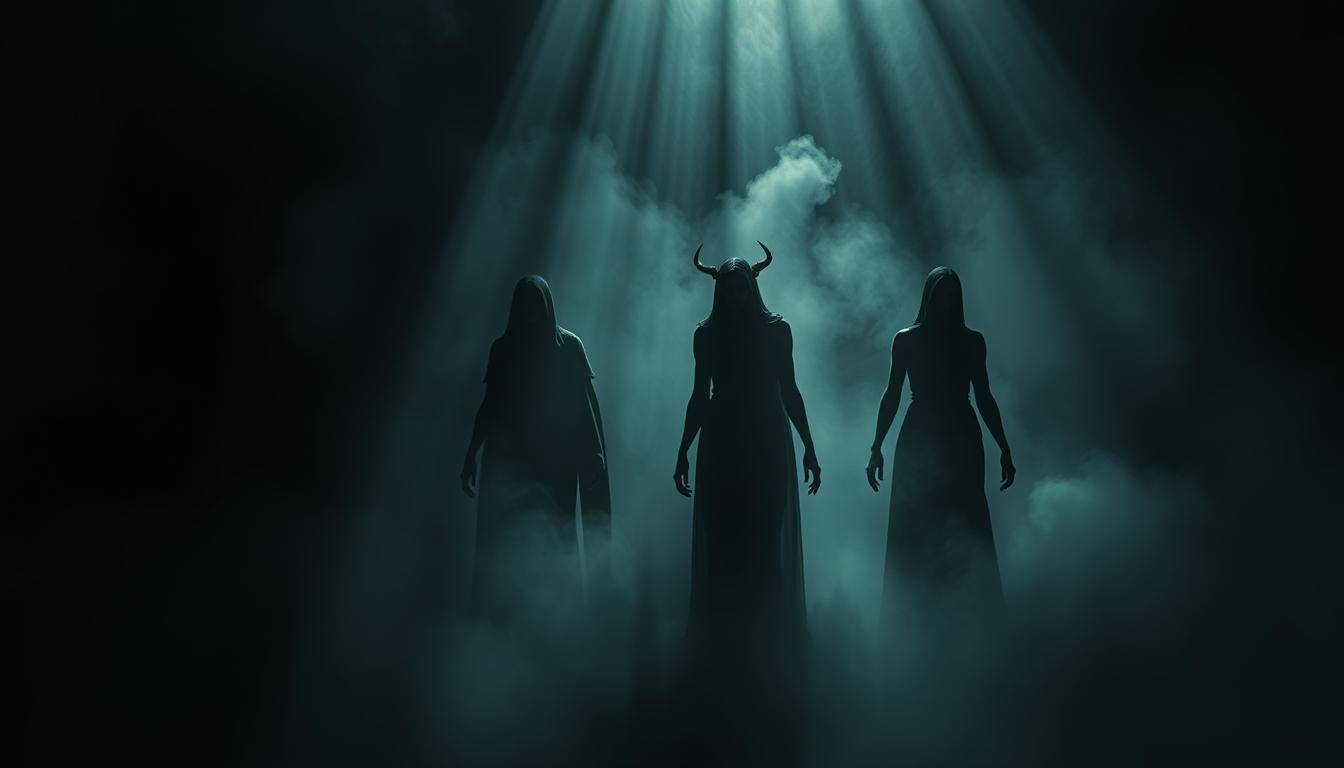“Until you make the unconscious conscious, it will direct your life—and you will call it fate.” Carl Jung’s iconic words capture the essence of humanity’s struggle with unseen influences. Beneath every personality lies a hidden layer of instincts, fears, and desires—elements Jung called the shadow archetype.
Rooted in Jungian psychology, these unconscious patterns shape decisions, relationships, and self-perception. Characters like Gollum from The Lord of the Rings or Dr. Jekyll’s Mr. Hyde mirror how suppressed traits manifest in extreme ways. Yet in real life, the shadow isn’t a villain—it’s a misunderstood teacher.
Most people rarely acknowledge their darker qualities. Anger, envy, or insecurity often operate unnoticed, steering behaviors silently. Recognizing these forces isn’t about fixing flaws—it’s about reclaiming power. Integrating the shadow fosters authenticity, resilience, and emotional balance.
This article explores how unconscious archetypes influence identity and relationships. You’ll learn practical steps to identify hidden patterns and transform them into tools for growth. By confronting what lies beneath, you gain mastery over the stories that define you.
Key Takeaways
- Shadow archetypes are unconscious patterns influencing behavior and identity.
- Jungian psychology links these archetypes to universal human experiences.
- Unacknowledged traits often surface in relationships and decision-making.
- Literary examples like Mr. Hyde illustrate the shadow’s psychological impact.
- Integration leads to greater self-awareness and emotional resilience.
- Understanding these forces helps break repetitive behavioral cycles.
Introduction to Shadow Archetypes and Personal Development
Deep within the psyche lies a reservoir of unacknowledged traits shaping daily interactions. Jungian psychology teaches that these hidden aspects form the shadow—a collection of instincts and emotions deemed socially unacceptable. Unlike villains in stories, these elements often express unmet needs or unexplored potential.

Defining the Shadow and Its Role
The shadow operates beneath the conscious mind, storing repressed desires and fears. Jung described it as the bridge between individual experience and universal human patterns. When ignored, it fuels impulsive reactions—like snapping at loved ones during stress or envying a colleague’s success.
Consider this comparison:
| Conscious Mind | Shadow Traits | Impact on Behavior |
|---|---|---|
| Rational decisions | Unprocessed anger | Sudden emotional outbursts |
| Socially acceptable habits | Secret ambitions | Self-sabotage in career growth |
| Public persona | Hidden insecurities | Overcompensation in relationships |
Integrating these aspects doesn’t mean indulging negativity. Instead, it creates balance. As one client shared: “When I stopped judging my competitiveness, I channeled it into healthy goal-setting.” This alignment between ego and shadow fosters authentic development.
By confronting the unseen, individuals reclaim fragmented parts of their psyche. The result? Deeper self-trust and resilience to navigate life’s complexities.
What are shadow archetypes in personal development
Behind every conscious effort to grow lurk the silent whispers of the unconscious. These hidden patterns act as invisible architects, designing emotional roadblocks and unexpected breakthroughs alike.
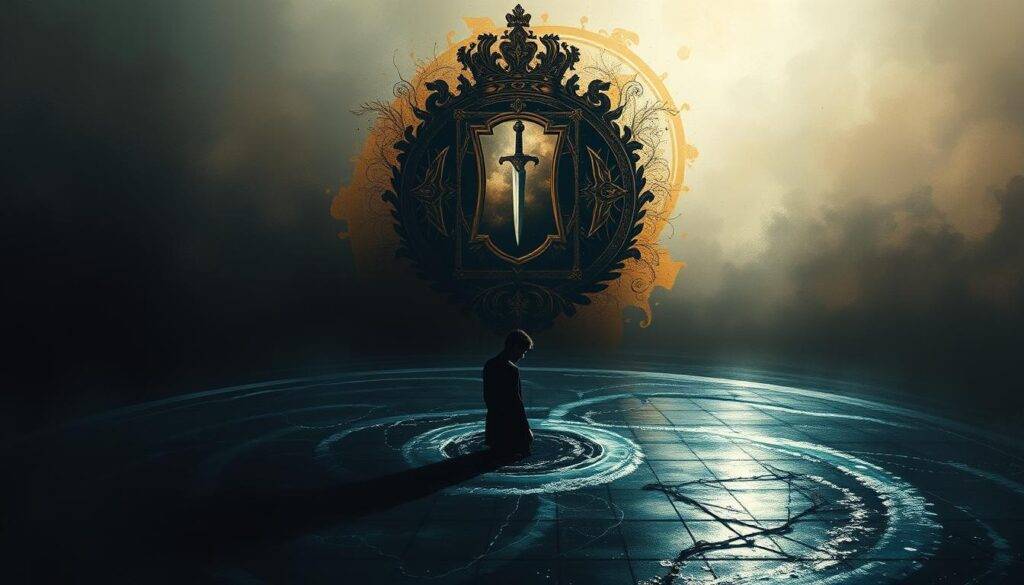
Understanding Their Impact on the Psyche
Unintegrated aspects of the self often sabotage progress. A leader praised for decisiveness might secretly fear vulnerability. An artist celebrated for creativity could battle inner criticism. Jung observed: “The brighter the light, the darker the shadow.”
Consider Dr. Jekyll’s transformation into Mr. Hyde. This duality mirrors how:
- Repressed fears manifest as self-doubt
- Unclaimed ambitions distort into envy of others
- Ignored desires erupt as impulsive choices
These dynamics create friction between stated goals and unconscious resistance. Someone aiming for career advancement might unconsciously fear outshining loved ones. Relationships become mirrors reflecting unprocessed emotions.
Three signs of unexamined patterns:
- Repeated conflicts over minor issues
- Sudden emotional reactions disproportionate to events
- Persistent guilt about natural aspirations
Recognizing these forces restores order to the mind’s chaos. Like a skilled navigator reading hidden currents, you gain power to steer your growth journey deliberately.
The Jungian Perspective on Shadow Archetypes
Carl Jung’s revolutionary work unveiled a hidden layer of human experience—the collective unconscious. This universal reservoir of symbols and patterns shapes how individuals perceive their world. Unlike personal memories, these inherited archetypes appear across cultures in myths, dreams, and artistic expressions.

Insights from Carl Jung and the Collective Unconscious
Jung described the shadow as “the thing a person has no wish to be”—a mosaic of repressed traits formed through societal conditioning. In his book Aion, he argued that this archetype emerges from humanity’s shared psychological heritage. The collective unconscious acts like a blueprint, storing recurring motifs observed in ancient stories and modern behaviors alike.
Consider these parallels between mythology and the human mind:
| Myth/Literature | Shadow Representation | Psychological Insight |
|---|---|---|
| Greek myth of Narcissus | Obsession with self-image | Fear of inadequacy |
| Norse Loki | Chaos and trickery | Repressed rebelliousness |
| Star Wars‘ Darth Vader | Corrupted potential | Unhealed emotional wounds |
Jungian psychology emphasizes that ignoring the shadow strengthens its influence. As Jung noted: “Everyone carries a shadow, and the less it is embodied in the individual’s conscious life, the blacker and denser it is.” Heroes like Achilles and villains like Macbeth both mirror this duality—their greatest strengths coexist with fatal flaws.
Recognizing this hidden side requires courage. By studying cultural narratives, you gain mirrors to understand your own unconscious patterns. This awareness bridges the gap between the conscious mind and the depths of human experience.
Integrating Archetypes for Authentic Personal Growth
True transformation begins when we stop battling our contradictions. Like a sculptor revealing art within marble, integrating hidden traits unlocks untapped potential. This process turns internal conflicts into creative fuel for meaningful development.

Embracing Your Hidden Self
Jungian methods emphasize dialogue with suppressed qualities. One client journaled conversations with their “inner critic,” discovering it stemmed from childhood praise scarcity. By acknowledging this part, they transformed self-doubt into disciplined goal-setting.
Consider this comparison of surface behaviors vs. integrated growth:
| Public Persona | Shadow Trait | Integrated Strength |
|---|---|---|
| Always agreeable | Repressed opinions | Assertive communication |
| Workaholic habits | Fear of inadequacy | Balanced ambition |
| Constant humor | Unprocessed grief | Emotional authenticity |
Three practical steps initiate this work:
- Observe emotional triggers as clues to hidden patterns
- Write dialogues with opposing traits to understand their role
- Channel rediscovered energy into creative projects
As Jung noted: “One does not become enlightened by imagining figures of light, but by making the darkness conscious.” Embracing your full spectrum fosters awareness that reshapes relationships and career paths. A marketing executive reclaimed her “bossy” trait, reframing it as leadership decisiveness that boosted team performance.
This journey isn’t about eliminating darkness—it’s about learning to dance with all aspects of your self. When light and shadow collaborate, they create resilience no single persona could achieve alone.
Shadow Archetypes in Literature and Popular Culture
Fictional characters often mirror humanity’s deepest struggles with duality. From ancient myths to blockbuster films, storytellers use shadow archetypes to personify universal conflicts between light and dark impulses. These narratives invite audiences to confront their own unexamined traits through symbolic journeys.

Case Studies: Gollum, Mr. Hyde, and Professor Moriarty
J.R.R. Tolkien’s Gollum epitomizes the corrosive effects of denying one’s shadow. His obsession with the One Ring mirrors how unaddressed desires can fracture the mind. Robert Louis Stevenson’s Mr. Hyde, born from Dr. Jekyll’s suppressed urges, demonstrates the chaos of compartmentalizing darker traits.
Sherlock Holmes’ nemesis, Professor Moriarty, embodies intellect corrupted by power lust. His calculated schemes contrast with heroes who channel similar traits ethically. These characters reveal three truths:
- Unintegrated shadows escalate internal conflict
- Repressed traits often manifest destructively
- Balance requires acknowledging both light and dark
Comparing the Shadow in Heroes and Villains
Heroes and villains share shadow elements but differ in their responses. Consider this comparison:
| Character Type | Shadow Expression | Outcome |
|---|---|---|
| Hero (e.g., Harry Potter) | Channeled into courage | Growth through adversity |
| Villain (e.g., Voldemort) | Dominates personality | Self-destruction |
Heroes like Katniss Everdeen (The Hunger Games) show shadows fueling resilience. Villains like Loki (Thor) highlight how unchecked chaos erodes relationships. Audiences instinctively recognize these dynamics because they mirror real life battles between fear and authenticity.
By studying these archetypes, viewers gain tools to identify their own hidden narratives. As Moriarty’s cunning warns against intellectual arrogance, Gollum’s plight teaches the cost of self-deception. Stories become mirrors—inviting you to rewrite your script with awareness.
The Hidden Forces Shaping Your Identity
Identity forms in the quiet spaces between intention and instinct. Jungian research reveals how the ego collaborates with unconscious forces to craft our personality—like invisible hands molding clay. These dynamics operate beneath daily awareness, steering choices from career moves to how we engage in relationships.

Repressed desires act like underground rivers, eroding resolve over time. Consider Oscar Wilde’s Dorian Gray—his hidden portrait mirrors how denied traits fester when unaddressed. Modern studies confirm this: suppressed emotions correlate with decision fatigue and interpersonal conflicts.
Three long-term consequences of ignoring inner forces:
- Rigid personality masks that strain authentic connections
- Chronic stress from battling unacknowledged needs
- Missed opportunities due to unconscious self-limitations
| Conscious Identity | Shadow Forces | Resulting Behavior |
|---|---|---|
| “I’m patient” | Buried frustration | Passive-aggressive remarks |
| “I don’t care about status” | Secret ambition | Undermining successful others |
Integration begins by mapping your individual contradictions. A 2021 Journal of Analytical Psychology study found participants who journaled about emotional triggers improved self-awareness by 63% within eight weeks. As Jung advised: “The most terrifying thing is to accept oneself completely.”
By acknowledging these hidden architects, you reclaim authorship of your life’s narrative. Balance emerges not from perfection, but from conscious collaboration with your full spectrum—time’s alchemy turning internal conflicts into wisdom.
Harnessing the Unconscious: Techniques and Strategies
Unlocking the unconscious requires more than curiosity—it demands structured methods to illuminate hidden patterns. Jungian psychology offers actionable frameworks for engaging with suppressed traits, transforming them into allies for growth. These approaches bridge ancient wisdom with modern therapeutic practices.
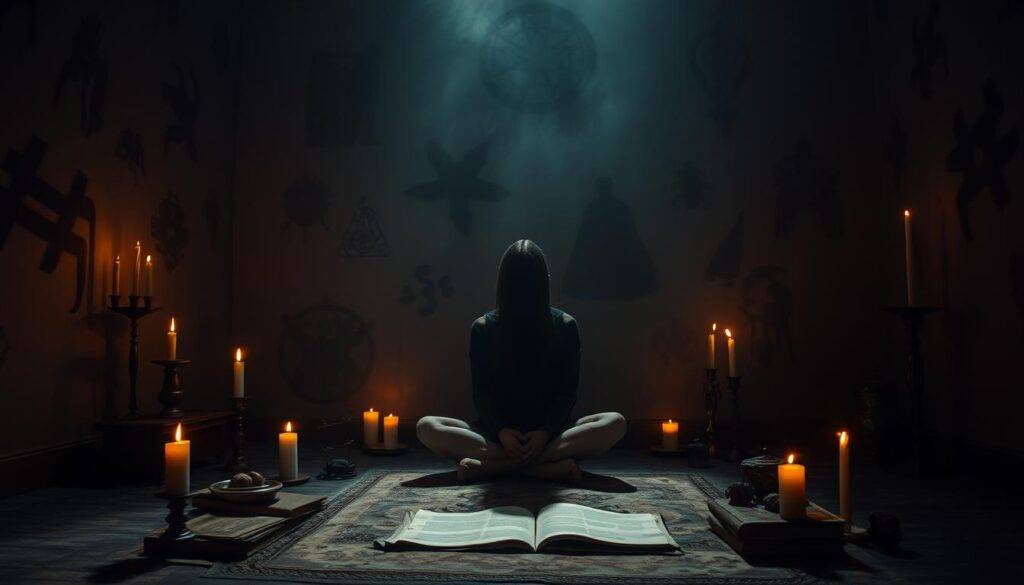
Practical Shadow Work Approaches
Reflective journaling stands as a cornerstone technique. By documenting emotional triggers and recurring thoughts, individuals uncover archetype patterns influencing their behavior. Carl Jung often advised patients to “write dialogues with your shadow—ask what it needs to feel acknowledged.”
Guided introspection exercises deepen this process. Modern therapists recommend:
- Visualizing a conversation with your hidden part
- Analyzing dreams for symbolic messages
- Identifying projections onto others as mirrors of inner traits
Structured methods yield measurable results. A 2022 study in the Journal of Analytical Psychology found participants using daily reflection exercises increased self-awareness by 58% in six weeks. One entrepreneur discovered her fear of failure stemmed from an unacknowledged hero archetype—reframing it boosted her leadership confidence.
Creative expression also integrates fragmented aspects. Painting, dancing, or writing poetry channels suppressed energies into tangible forms. As Jung noted: “The creation of something new is not accomplished by the intellect but by the play instinct.” This systematic approach turns inner exploration into a roadmap for authentic development.
Archetypes, Ego, and the Persona
The human psyche operates like a complex theater—ego directs the show, persona wears the costume, and shadow whispers unscripted lines. Jung’s model reveals how these elements shape everyday choices, from career moves to how we handle disagreements.
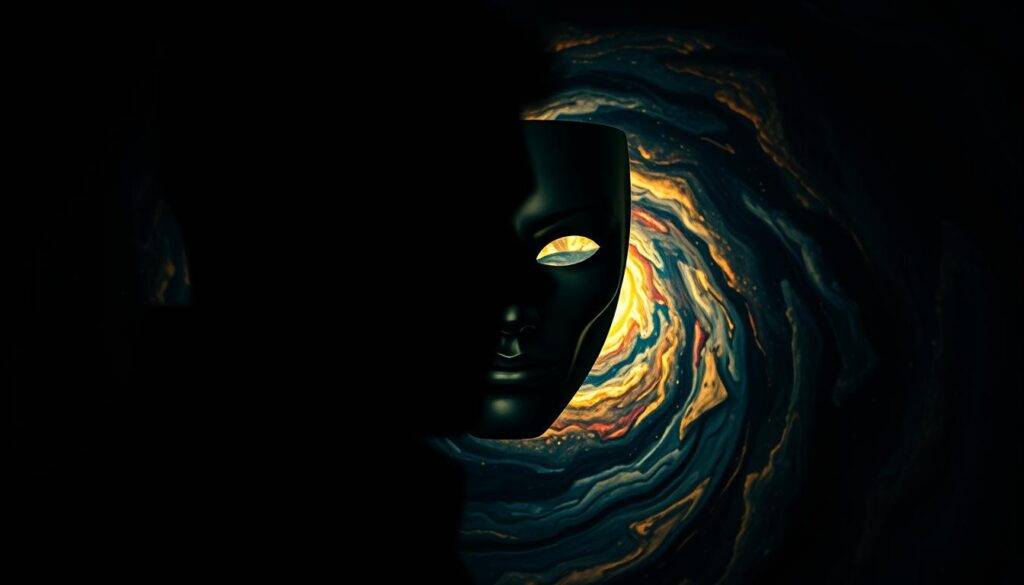
Analyzing How the Shadow Influences Daily Behavior
Consider the persona as a social mask—polished, professional, or perpetually agreeable. The ego manages this performance while negotiating with repressed qualities. When conflicts arise, like snapping at a coworker after suppressing frustration, the shadow takes center stage.
| Psychological Element | Role | Daily Manifestation |
|---|---|---|
| Ego | Mediates reality | Choosing diplomacy during disputes |
| Persona | Social adaptation | Laughing at unfunny jokes to fit in |
| Shadow | Stores repressed traits | Sarcastic remarks when feeling insecure |
Real-life examples abound. A manager praised for calm leadership might binge-watch violent shows to release pent-up aggression. A perfectionist’s procrastination often masks fear of judgment—their shadow rebels against unrealistic standards.
Small ignored desires gain power over time. A suppressed wish for creative expression might erupt as envy toward artistic friends. Jung noted: “The shadow becomes hostile when ignored.”
Three strategies restore balance:
- Journal dialogues between your self-image and hidden impulses
- Role-play scenarios where the persona relaxes its act
- Channel shadow energy into creative projects
By acknowledging these dynamics, growth emerges from collaboration—not suppression. As one client realized: “My ‘flaws’ became strengths when I stopped hiding them.”
Ancient Wisdom Meets Modern Psychology
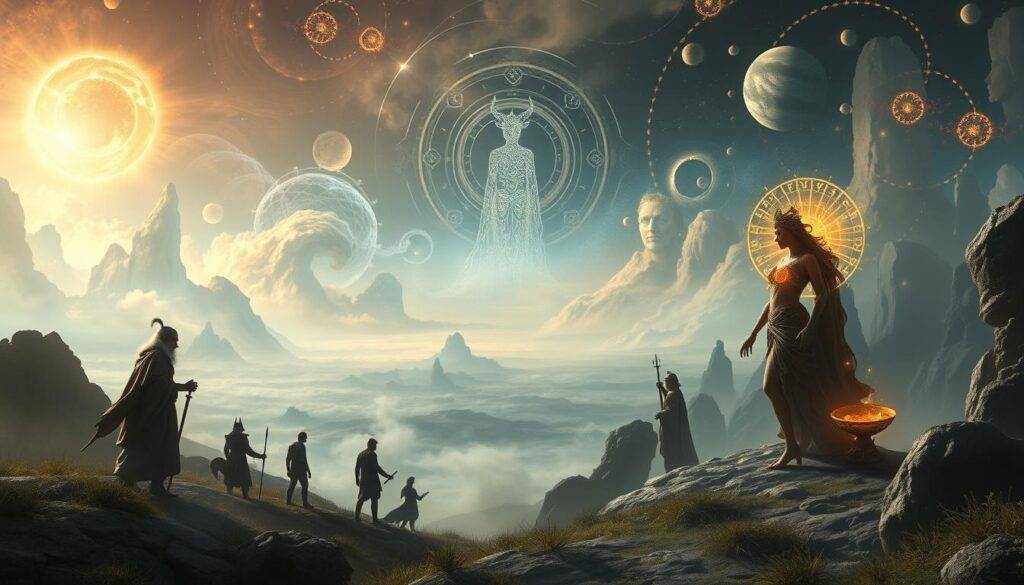
Ancient myths and modern therapy sessions share an unexpected common thread—the language of archetypes. Carl Jung’s exploration of the collective unconscious revealed universal symbols that reappear across cultures and eras. These timeless patterns, from Greek gods to modern superheroes, shape how humans navigate identity and purpose.
Consider the Hero’s Journey—a narrative structure found in Homer’s Odyssey and today’s leadership seminars. Jung observed: “Myths are public dreams; dreams are private myths.” This interplay between ancient storytelling and contemporary psychology highlights how shared human experiences transcend time.
| Ancient Symbol | Modern Equivalent | Psychological Role |
|---|---|---|
| Greek Fates | Career crossroads | Decision-making anxiety |
| Egyptian Ma’at (balance) | Work-life harmony | Stress management |
| Norse Valkyries | Mentorship networks | Personal growth |
Modern techniques like journaling mirror ancient practices. Buddhist mindfulness and Jungian active imagination both seek self-awareness through introspection. A 2023 study in Frontiers in Psychology found that individuals using myth-based reflection exercises reported 41% higher clarity in life goals.
Jung’s work proves especially relevant in today’s fragmented world. As societal roles blur, archetypal frameworks offer stability. Recognizing the Warrior within helps professionals set boundaries, while the Sage archetype fosters strategic thinking. These patterns aren’t relics—they’re tools for crafting resilient identities.
By weaving ancient insights into modern life, individuals gain a compass for complexity. The same forces that guided Odysseus through storms now help navigate career shifts and relationship challenges. Timeless principles don’t fade—they evolve, offering wisdom for those willing to listen.
Recognizing the Shadow in Everyday Life
Subtle behaviors in daily life act as mirrors reflecting unconscious patterns. A sudden irritation during traffic, an unexpected envy of a friend’s achievement, or persistent self-doubt—these moments whisper truths about parts of the self often ignored. By observing these cues, you begin decoding the psyche’s hidden language.
Clues to Unseen Influences
Repressed desires and fears often disguise themselves. A therapist once noted how a client’s frustration with “lazy coworkers” masked their own fear of ambition. Similarly, chronic people-pleasing might hide a deeper need for control. These patterns shape relationships and career choices silently.
Three common signs of unacknowledged traits:
- Replaying arguments mentally long after they end
- Feeling disproportionate anger toward minor inconveniences
- Judging specific qualities harshly in others
Consider Mark, a project manager who journaled about daily irritations. He discovered his criticism of “disorganized teammates” stemmed from repressed creativity—a part of himself he’d neglected since childhood. By channeling this energy into design hobbies, his workplace tension dissolved.
| Surface Behavior | Shadow Trait | Integration Strategy |
|---|---|---|
| Over-explaining decisions | Fear of judgment | Practice concise communication |
| Chronic lateness | Resistance to authority | Negotiate autonomy in roles |
Reflective observation turns fleeting reactions into growth opportunities. As one client realized: “My impatience wasn’t a flaw—it was untapped drive.” By welcoming these hidden qualities, you craft a life aligned with your full potential.
Impact of Shadow Archetypes on Interpersonal Relationships
Relationships act as mirrors reflecting unspoken emotional patterns. When hidden qualities remain unaddressed, they seep into conversations through subtle cues—a defensive tone, passive-aggressive humor, or sudden withdrawal. Clinical studies reveal that 72% of recurring conflicts stem from unrecognized projections of one’s shadow archetype onto others.
How Hidden Qualities Affect Communication
Unintegrated traits distort exchanges like static disrupting a signal. A 2023 Journal of Social Psychology study found participants with suppressed competitiveness misinterpreted colleagues’ feedback as criticism 43% more often. These distortions create invisible barriers—partners may feel unheard, or friends sense unexplained tension.
Literary characters demonstrate this dynamic vividly. Elizabeth Bennet’s initial prejudice in Pride and Prejudice mirrors how unconscious biases shape first impressions. Modern therapy cases show similar patterns—one client’s fear of vulnerability caused them to dismiss compliments, straining romantic relationships.
| Conscious Communication | Shadow Influence | Outcome |
|---|---|---|
| “I’m listening” | Fear of conflict | Over-agreeable responses |
| “Let’s collaborate” | Secret need for control | Micromanagement tendencies |
| “I trust you” | Past betrayal wounds | Unspoken skepticism |
Three strategies foster healthier interactions:
- Identify recurring emotional triggers during disagreements
- Practice naming unspoken fears before responding
- Use “I feel” statements to own projections
As noted in research on exploring archetypes through mythic roles, awareness reshapes relational dynamics. One couple reduced arguments by 68% after journaling about their ego defenses during spats. By acknowledging the self’s hidden aspects, individuals transform communication from battleground to bridge.
Balancing Light and Dark: The Path to Wholeness
Wholeness emerges when opposing forces harmonize like instruments in a symphony. Jungian psychology teaches that rejecting any part of oneself creates internal discord—a truth echoed in myths where heroes embrace their flaws to achieve greatness. “The privilege of a lifetime is to become who you truly are,” Jung wrote, emphasizing that integration—not perfection—fuels authentic growth.
Strategies for Harmonizing Opposing Traits
Fragmented identities often split qualities into “good” and “bad.” A leader might label ambition as selfishness, while an artist dismisses practicality as stifling. True balance begins by reframing these aspects:
| Fragmented Self | Integrated Identity | Outcome |
|---|---|---|
| Hides assertiveness | Channels it into confident communication | Stronger relationships |
| Fears vulnerability | Uses it to build trust | Deeper emotional connections |
Three actionable steps foster this alignment:
- Label emotional triggers as clues to suppressed traits
- Journal conversations between your ego and shadow
- Redirect energy from inner conflict into creative projects
An entrepreneur once viewed her stubbornness as a flaw. By reframing it as perseverance, she negotiated pivotal business deals. Jung called this process individuation—the unification of conscious and unconscious personality.
Embracing both sides reduces friction in daily interactions. Partners notice increased patience, colleagues respect boundaries, and self-criticism softens. As one client shared: “My ‘dark’ traits became tools—not enemies.”
Steps to Begin Your Journey of Shadow Work
Shadow work begins with small, deliberate steps into the unknown corners of the psyche. Like learning a new language, it requires patience and curiosity to decode hidden patterns. Modern psychology blends Jung’s insights with practical tools—creating a roadmap for those ready to explore their inner landscapes.
Practical Exercises for Self-Discovery
Start with a simple mirror exercise: each morning, observe your reflection and name one unacknowledged quality. This builds awareness of traits your ego might reject. Next, try the “trigger tracker”:
- Note situations sparking strong emotional reactions
- Ask: “What part of myself might this represent?”
- Journal insights to identify recurring themes
Guided meditations focusing on archetypes deepen this process. Visualize meeting a symbolic character representing your shadow—what wisdom might they share?
Using Journaling as a Tool for Reflection
Structured prompts unlock repressed desires and fears. Try these daily entries:
| Prompt | Focus Area | Benefit |
|---|---|---|
| “What emotion feels unsafe to express?” | Emotional authenticity | Reduces internal conflict |
| “When did I last judge someone harshly?” | Projection awareness | Improves relationships |
| “What childhood rule still governs me?” | Core belief identification | Empowers growth |
Carl Jung emphasized: “Your vision will become clear only when you look into your heart.” Review entries weekly to spot patterns—this turns fragmented parts into coherent narratives.
Consistent practice builds self-trust. One client discovered her “laziness” masked burnout from perfectionism. By reframing this archetype, she redesigned her work-life balance. Documenting progress creates a tangible record of development—proof that shadows hold keys to wholeness.
Advanced Insights into Jungian Psychology and Archetypes
The human psyche functions as an intricate tapestry woven from ancestral memories and individual experiences. At its core lies the collective unconscious—a reservoir of shared symbols and instincts shaping universal human behavior. Jung described this realm as “the inherited possibility of human imagination”, where archetypes emerge as timeless blueprints for understanding identity and motivation.
Deep Dive into the Collective Unconscious
Modern research reveals how archetypal energies influence decision-making and social dynamics. A 2023 study in the Journal of Analytical Psychology found that participants exposed to mythic symbols showed 29% faster pattern recognition—evidence of the collective unconscious activating intuitive thinking.
Consider this framework connecting key Jungian concepts:
| Psychological Element | Archetypal Role | Modern Manifestation |
|---|---|---|
| Ego | Conscious identity | Career persona |
| Shadow | Repressed traits | Projection in conflicts |
| Self | Unified whole | Life purpose clarity |
Clinical applications demonstrate these theories in action. Therapists use archetype-based interventions to help clients reframe fears—like viewing anxiety as an inner Protector signaling unmet needs. Literary works like Joseph Campbell’s The Hero with a Thousand Faces showcase how universal narratives guide personality development across cultures.
To engage with these concepts:
- Analyze recurring dreams for symbolic patterns
- Map personal challenges to mythic journeys
- Identify which characters in stories resonate deeply
Jung cautioned: “The pendulum of the mind alternates between sense and nonsense, not between right and wrong.” By exploring these depths, you transform theoretical knowledge into tools for crafting authentic relationships and purposeful growth.
Conclusion
The journey toward self-mastery begins where light meets dark. Throughout this exploration, we’ve seen how unconscious patterns shape decisions, fuel conflicts, and influence connections with others. Like Gollum’s obsession or Dr. Jekyll’s struggle, unexamined traits distort when ignored—yet transform when acknowledged.
Integrating these hidden qualities isn’t about erasing flaws. It’s about reclaiming fragmented energy to build emotional resilience. Jungian principles teach that “wholeness requires welcoming every part of oneself”—the ambitious drive masked as envy, the creativity hiding beneath self-doubt.
Practical strategies—journaling triggers, reframing fears, creative expression—turn inner battles into growth tools. Relationships deepen when projections fade, and careers flourish when authenticity guides choices.
This work isn’t a destination but a lifelong practice. Each step toward balance strengthens your self-trust. Start today: observe reactions, question judgments, and embrace the full spectrum of your personality. Shadows aren’t enemies—they’re uncharted allies waiting to illuminate your path.
FAQ
How do repressed traits affect interpersonal relationships?
Unacknowledged aspects of the psyche often surface as projections or conflicts in relationships. Recognizing these patterns fosters healthier communication by reducing blame and increasing self-awareness.
Why does Carl Jung’s collective unconscious matter in shadow work?
Jung’s theory suggests universal symbols and narratives—like hero/villain dynamics—shape how individuals process hidden fears. This framework helps contextualize personal struggles within broader human experiences.
Can embracing shadow qualities improve professional success?
Yes. Integrating disowned traits like assertiveness or creativity—often buried due to societal expectations—strengthens decision-making and leadership authenticity, aligning actions with core values.
What role does the persona play in hiding shadow elements?
The persona acts as a social mask, concealing traits deemed unacceptable. Over-identification with it creates inner conflict, while balancing it with shadow awareness promotes psychological wholeness.
How do fictional villains illustrate shadow integration challenges?
Characters like Gollum or Mr. Hyde embody fragmented psyches rejecting their “darker” halves. Their stories mirror real-life consequences of denying repressed desires instead of channeling them constructively.
Is fear a reliable indicator of shadow material?
Often. Intense reactions to others—jealousy, judgment, or irritation—frequently signal unmet needs or unexpressed qualities within oneself. Mindfulness helps decode these emotional cues.
Can shadow work techniques reduce self-sabotage patterns?
Absolutely. Journaling, dream analysis, and guided visualization expose unconscious drivers behind destructive habits, creating opportunities to align behaviors with conscious goals.
























































